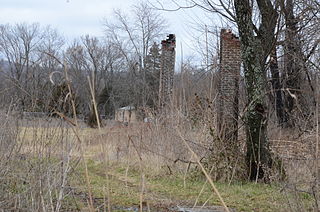
The Durham School was a historic schoolhouse on Durham Road in Durham, Arkansas. It was a single-story Craftsman style stone structure, with a gable roof, and entrances at the opposite gable ends. Built in 1829, the school had three classrooms and space for a teacher's living quarters. It was used until the Durham school district was consolidated into that of Elkins in 1948. It was listed on the National Register of Historic Places in 1982. The building has since been destroyed by fire, and was delisted from the Register in 2018.

The Old Union School is a historic school building at 504 Old Union Road in Birdell, Arkansas. It is a single-story wood frame Plain Traditional structure, with a corrugated metal gable roof and a stone foundation. Built in 1913, it is one of the few older structures in Birdell, and the only one-room schoolhouse in southwestern Randolph County. The building was used as a school until 1941, and saw only occasional use for other community purposes until 1991, when it underwent a major restoration. It is now used as a community hall.

This is a list of the National Register of Historic Places listings in Cleburne County, Arkansas.

The Clarence Frauenthal House is a historic house at 210 North Broadway in Heber Springs, Arkansas. Clarence was a son of Heber Springs founder, Max Frauenthal. It is a single-story wood frame structure, with a gabled roof, redwood siding, and a sandstone foundation. The main roof has its gable to the front, with a number of side gables, one of which extends to a flat-roofed porte-cochere on the right, another, extends one roof face forward over the front entry porch, and a third covers a projecting side ell. The front porch is supported by square posts, and shows exposed rafters. The house was built in 1914, and is Heber Springs' best example of Craftsman architecture. The house was listed on the U.S. National Register of Historic Places in 1993. Upon the dealth of Clarence's son Julian, the home was sold to the Cleburne County Historical Society; in 2017 the Historical Society sold the home to Clarence's grandson Max Don.

Turkey Creek School is a former school building located along Arkansas Highway 9 in Stone County, Arkansas. It is a single-story wood frame structure, with a metal gable roof, weatherboard siding, and a stone foundation. The north facade has a symmetrical pair of entrances with simple trim, and the sides have five sash windows. Although it was built in 1925, the school resembles much older rural schoolhouses. It was used as a school until 1949, and now serves as a local community building.
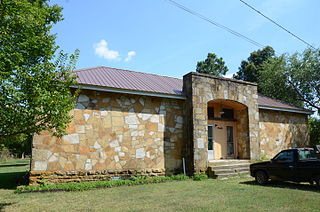
The Alco School is a former educational facility located just north of Arkansas Highway 66 in rural western Stone County, Arkansas, not far from the hamlet of Alco. It is a single-story stone structure, with a hip roof that has two eyebrow dormers. The main entry is on the western facade, sheltered by a parapeted porch. The interior originally had two classrooms, and has been converted to residential use. The school was built in 1938 as a National Youth Administration works project.
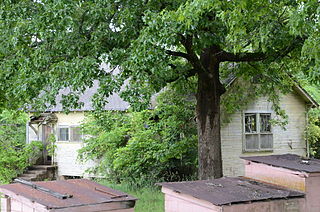
The Cafeteria Building of the Cleveland School is a historic school building in rural Conway County, Arkansas. It is located near the hamlet of Cleveland, on the south side of Center School Road. It is a single-story wood frame structure, with a gable-on-hip roof, weatherboard siding, and a foundation of stone piers. It has vernacular Craftsman styling, with exposed rafter ends in the eaves, large Craftsman brackets in the gables, and bracketed hoods sheltering the entrances. It was built about 1930, and initially served as a cafeteria for an adjacent elementary school; it was later converted to classroom use.

The Bluff Springs Church and School is a historic dual-purpose building in rural northwestern Stone County, Arkansas. It is located west of Onia, near the junction of county roads 136 and 140. It is a rectangular box-constructed structure, topped by a gable roof with a small belfry on top. It is covered with weatherboard siding and rests on stone foundation. The south-facing front has a pair of entrances, symmetrically placed, and there is a shed-roof addition to the north end. Built in 1900, it is one of the oldest school buildings in the county.

Aggie Hall is a historic former gymnasium in Bruno, Arkansas, a short way south of Arkansas Highway 235. It is a single-story stone structure, topped by a hip roof which has a clerestory section at its center. The clerestory is finished in weatherboard; both roof lines have Craftsman-style exposed rafter ends. The building was erected in 1926 by the student members of the Lincoln Aggie Club, believed to be the first chapter established of the Future Farmers of America, and was originally intended as a gymnasium for the adjacent Bruno School and as a location for the club's activities.

Hirst-Mathew Hall is a historic school building in Bruno, Arkansas. It is located in a complex included several other school buildings south of Arkansas Highway 235, between County Roads 5008 and 5010. It is a single-story stone structure, with a gable-on-hip roof that has exposed rafter ends in the Craftsman style. The main (north-facing) facade has a centered gable-roof porch supported by four columns set on a raised concrete base. The east facade has 14 windows, placed asymmetrically in groups of 6, 3 and 5. The west facade has 12 windows in two groups of 6. It was built in 1929 as part of the Bruno Agricultural School, and originally housed classrooms. When it was listed on the National Register of Historic Places in 1992, it was in use as a textile factory.

The Grubb Springs Community Building, formerly the Grubb Springs School, is a historic school building in Boone County, Arkansas. The building is a single-story stone gable-roofed structure located northeast of the junction of Arkansas Highways 43 and 397, west of Harrison. Construction began on the building in 1892 by the local Methodist congregation, intending its use as a church. The land and unfinished building were sold in 1896 to the local school district, which completed the building. It was used as a school until 1944, and has since been converted into a community center.
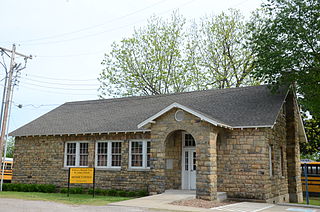
The Mulberry Home Economics Building is a historic school building in Mulberry, Arkansas. It is a single-story stone and masonry structure, located off West 5th Street behind the current Mulberry High School building. It has a rectangular plan, with a gable-on-hip roof and a projecting gable-roof entry pavilion on the north side near the western end. The pavilion exhibits modest Craftsman styling, with exposed rafters in the roof and arched openings. The south facade has a secondary entrance near the eastern end, and four irregularly sized and spaced window bays to its west. The building was erected in 1939 with funding assistance from the National Youth Administration.

The Luber School is a historic school building in rural central-southern Stone County, Arkansas. It is located at the northern corner of Luber Road and County Road 214 in the community of Luber, south-southeast of Mountain View. The school is a single story rectangular stone structure, with a hip roof that has exposed rafter ends in the Craftsman style. A hip-roofed porch projects to the south, supported by square columns, and shelters the main double-door entrance. The school was built by the small rural community in 1930, just before the full effects of the Great Depression and a drought ruined the area's economy.
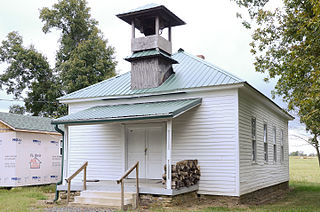
The Brewer School is a historic school building on Brewer Road in Brewer, Arkansas. It is a vernacular single-story wood frame structure, with a hip roof, weatherboard siding, and a stone foundation. A shed-roof porch shelters the entrance, and a belfry projects from the front slope of the roof. The school was built in 1910, and served as a one-room schoolhouse until 1950. It is still used as a community meeting and polling place.

The Cleburne County Courthouse is located at Courthouse Square in the center of Heber Springs, the county seat of Cleburne County, Arkansas. It is a two-story brick building, built in the Jeffersonian Revival style in 1914 to a design by Clyde A. Ferrell. It has a symmetrical facade, with slightly projecting wings on either side of a central entrance. The entrance is fronted by a projecting four-column Classical portico with gabled pediment. The building is topped by a large octagonal cupola.

The T.E. Olmstead & Son Funeral Home is a historic commercial building at 108 South Fourth Street in Heber Springs, Arkansas. It is a single-story stone structure, with a parapeted sloping roof. It has a single storefront, with a recessed entry flanked by plate glass display windows. Built in 1910, it is the city's only funeral home, and one of its early stone commercial buildings.

The Quitman Home Economics Building is a historic school building on 2nd Avenue in Quitman, Arkansas. It is a single story masonry structure, with walls of fieldstone and brick trim around the openings. The roof is gabled, with exposed rafter ends, and a shed-roof extension over the main entrance, supported by large brackets, all in the Craftsman style. It was built in 1938 with funding from the National Youth Administration.

The Solomon Grove Smith–Hughes Building is a historic community building on Solomon Grove Road in Twin Groves, Arkansas. It is a single-story stone structure, built out of locally quarried stone and covered by a gable-on-hip roof. It was built in 1938 with funding support form the Works Progress Administration, and first served as a school. It was built by the African-American mason Silas Owens Sr. on land he sold to the city in 1937. It now houses a library.

The O.D. Gunn Trade and Sale Barn is a historic commercial agricultural building at 10 Anna Street in Quitman, Arkansas. It is a rectangular wood-frame structure with a monitor gabled roof. Its exterior is clad in metal sheathing scored to resemble brick. The roof has exposed rafter ends, and heavy Craftsman style brackets at the front-facing gable end. It was built about 1910 by Offie Dorris Gunn, who used it to deal in horses and mules. It is a particularly well-preserved barn of the type used for this purpose in the early 20th century.





















